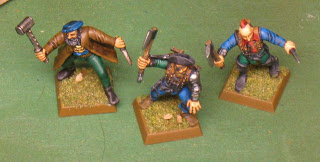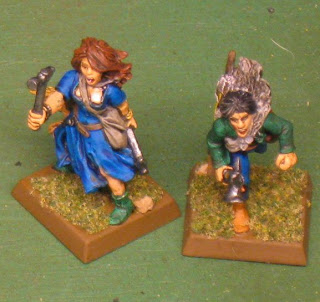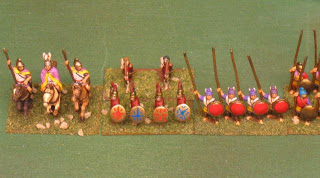I finished painting another DBA army. This is a 15mm Skythian army, DBA I/43a, with all options.
These Skythians portray a skill that definitely falls outside the realm of the Jack: riding a horse with only a horse blanket, before stirrups were invented, while using both hands to fire your bow, and simultaneously avoiding being killed by your enemy.
 The bulk of these figures are from a Falcon Figures DBA v1 army pack. The two stands of light horse with riders facing forward and the Auxilia are Essex. The Falcon metal was very brittle, so I mounted these on thick Litko Aerosystems plywood bases with plasteel on the bottom, to pick them up without touching the figures. I’m not that happy with the base edges, I’m more of a thin base sort of guy.
The bulk of these figures are from a Falcon Figures DBA v1 army pack. The two stands of light horse with riders facing forward and the Auxilia are Essex. The Falcon metal was very brittle, so I mounted these on thick Litko Aerosystems plywood bases with plasteel on the bottom, to pick them up without touching the figures. I’m not that happy with the base edges, I’m more of a thin base sort of guy.
 The general can be either cavalry (3Cv) or one of the light horse (2LH) elements. Just like in real life, it’s hard to tell who the general is. Skythians were famed for their hit and run horse archers, and in DBA the army can be fielded with all 12 elements as light horse. This can make them very difficult to control. I think they might also work better on a 30″ board instead of 24″, for extra room on the flanks to avoid the “end of the world” phenomenon.
The general can be either cavalry (3Cv) or one of the light horse (2LH) elements. Just like in real life, it’s hard to tell who the general is. Skythians were famed for their hit and run horse archers, and in DBA the army can be fielded with all 12 elements as light horse. This can make them very difficult to control. I think they might also work better on a 30″ board instead of 24″, for extra room on the flanks to avoid the “end of the world” phenomenon.
 Here, the Essex light horse figures are in the rightmost column. The Falcon horses were separate from their riders, which made them easier to paint and then assemble later. I epoxied the riders on, after clearing a spot down to bare metal on both parts. The epoxy is transparent, and not really visible even where there’s too much. In fact, I used epoxy on some of the bows to help prvent them from snapping off as well.
Here, the Essex light horse figures are in the rightmost column. The Falcon horses were separate from their riders, which made them easier to paint and then assemble later. I epoxied the riders on, after clearing a spot down to bare metal on both parts. The epoxy is transparent, and not really visible even where there’s too much. In fact, I used epoxy on some of the bows to help prvent them from snapping off as well.
I used Essex figures to fill in the figures missing from the DBA v1 army list, to bring it up to DBA v2 standards. I was surprised to see the skins on the backs of the Essex light horse: I thought they all rode with saddle blankets. Reading about them in the Osprey book, it turns out those are “the flayed skins of their enemies,” thus the general lack of hair. On the other side of the horse, there’s also a scalp. The Falcon figures were portrayed as much more civilized.
 Here is one element of auxilia (3Ax, Skythian javelins) and two elements of psiloi (2Ps, the archers). The auxilia are Essex figures.
Here is one element of auxilia (3Ax, Skythian javelins) and two elements of psiloi (2Ps, the archers). The auxilia are Essex figures.
Unfortunately I didn’t get any female horse archers. Apparently they rode side by side with the men, which would be wonderful to portray if the figures were more readily available. Skythians wore colorful tunics, with decorative stripes down their arm and leg seams, and around their necks, and goofy Smurf hats. I might have preferred to see more different horse and rider poses for the Falcon light horse, but they’re so colorful that it hardly matters.
I had fun painting this army, and I’m quite happy with how well it turned out. When I finished, I decided not to paint another DBA army for a while, but I think I’ve already changed my mind.
But after I finish painting a few DBA camps, I’ll most likely be painting fantasy naval vessels for Uncharted Seas.






